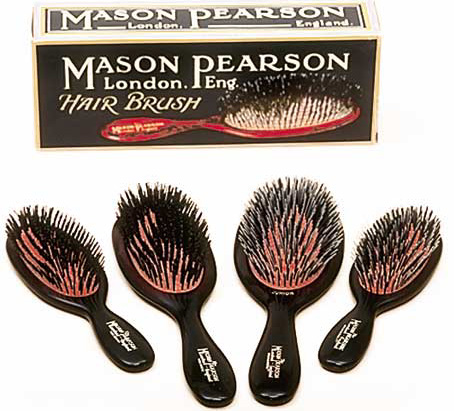Grooming
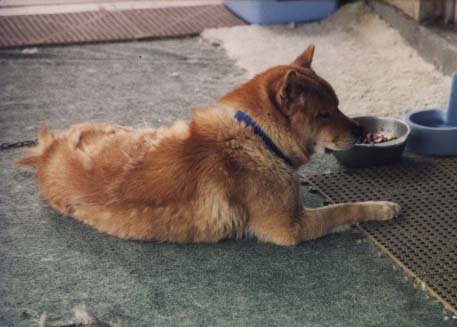
Hwang Dol Yi in a MAJOR shed.
photo by Jhun Kim |
Owning a Jindo means dealing with lots of fur. A Jindo will shed at least two times a year. If the Jindo is a pup, the pup will have a puppy shed after a couple months of age. An unspayed female will shed more often then males.
Once the Jindo begins shedding, I recommend the rake comb to take most of the shedding fur off in clumps, followed by a wire slicker brush to pull off any individual loose hairs.
A rubber curry brush works very well at pulling out loose guardhairs, especially the short hairs on the head and legs. The rubber curry brush is meant to be used wet during baths, but I've used it dry during the second half of the shed season and am very happy about it. The dogs don't enjoy the rubber curry brush very well though as it could tug hairs that aren't loose.
I've heard the greyhound comb also being used for guard hairs. I haven't purchased one so I couldn't say whether it'll be very effective.

shedding rake
(for undercoat)
|
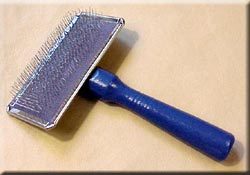
slicker brush
(for undercoat and guard hairs)
|
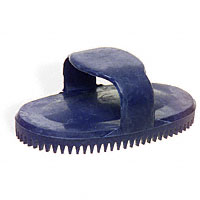
rubber curry brush
(for shedding guard hairs) |
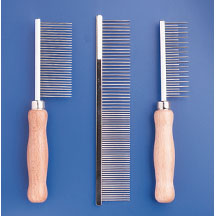
greyhound comb (center) |
If you don't mind paying a bit more for a higher quality brush (~$25) , I highly recommend a Chris Christensen pin brush. People use it mainly for brushing out the undercoat. It's very effective in retaining ALL the undercoat it takes off and doesn't leave a mess (with multiple dogs, that's very much a factor).
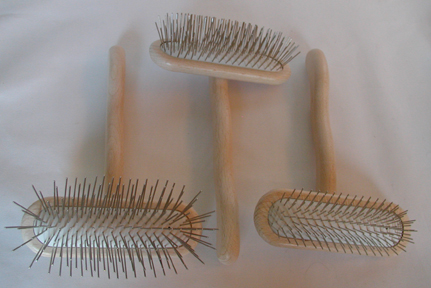
Chris Christensen T-brush |
However, I think the best use of this brush is as a skin stimulator or massager. This brush is slightly less effective than the rake comb during shed season, but it more than makes up for it as a year-long tool to bring blood circulation to the skin and encouraging a healthy skin. The pins are rounded and does not scratch the dog's skin. Because the brush gives as it's being used, it doesn't break or damage hairs. All my dogs love this brush and never pull away even when brushed with pressure.

Furminator |
I do own a Furminator and have mixed feelings about it. On one dog with longer length hair, the guard hairs would break, even when going in the direction of the hair, and sometimes the brush would pull the guard hairs out by the roots. On another dog with shorter length hair, the Furminator worked as advertised. However, in dry climates, be prepared for static build-up.
If you don't mind spending A LOT more for a world-reknown brush (~$100), the Mason Pearson English brush, made out of boar-bristles, is great for brushing out the shorter hairs on the legs and head. Because the brush is made out of real hairs instead of plastic or nylon, it pulls out the loose hairs and dirt that clings to the dog's hairs better than most brushes. The brush also works well in re-distributing the natural oils in the coat.
In Korea, Jindos are hardly ever given baths, but I've found that warm baths seems to speed up the shedding process. It's a good idea to introduce regular brushes and occasional baths at an early age (after 8 weeks of age) so that the dog learns to tolerate and even enjoy the extra attention he gets during the baths. Placing a towel at the bottom of a tub helps to prevent slipping by the dog and avoids an even more unpleasant experience. Dog-specific shampoos should be used as human shampoos or soaps are not pH balanced for dogs. Human shampoos and soaps will stripe the natural oils from a dog's coat and skin and leave behind a brittle feeling fur and dry flackly skin.
If your Jindo does not have an opportunity to exercise on hard ground, his or her nails may need to be clipped regularly. I've noticed that among my dogs, black nails are stronger than grey or white nails and don't tend to wear down as fast. For the novice, a guillotine nail clipper works fine. A human nail clipper will not work as it squeezes the nail before it cuts, thus hurting the dog. Make sure you don't cut into the quick or blood vessel in the nail. If uncertain where the quick is, ask a vet or dog groomer to cut the dog's nails and show you where the quick is before trying it on your own.
Depending on a dog's diet, teeth brushing may be required to kept your dog's gums healthy and breath smelling clean. Most Koreans I know find this rather gross and would rather give bones to their dogs instead. If one prefers to give cooked bones, make sure that the bone is either the soft beef knuckle bone (soup bone) or an uncrackable beef marrowbone to avoid the possibility of the dog swallowing large sharp splinters and puncturing his/her digestive tract. I tend to regards rib bones (i.e. Kalbi bones) with reservations. The thin bones with a cross-section of one cm are probably weak enough for the dog to crush, but there are some dogs that tend to swallow these bones whole which could cause a problem. The longer rib bones (1 inch, 2 inch, or longer) are very problematic. Since these aren't weight-bearing bones, they have the possibility of splintering into long sharp sections.
If one prefers to give raw chicken wings and necks as in the BARF (Bones and Raw Food) diet, make sure the chicken is fresh to avoid the possibility of overloading the dog's system with salmonella. Whenever possible, seek out organically grown meat as there could be residual hormones present and not destroyed by cooking. Make sure the raw parts are covered with raw meat and skin so that any splinters are coated.
Giving rawhides could be an option, but from personal experience, I've found that they're not as effective as bones. Even the stiffest rawhide, the compressed rawhide, does not do much to scrape off plaque and tartar after it becomes moisten and softened with dog saliva. Also, large unchewed pieces of rawhide can cause lethal blockages in the dog's intestinal tract.
Edible nylabones seem harmless so far although not as effective as bones and not as appetitizing to my dogs. I do not recommend cow hooves as my strongest chewer chipped her fang on it.
No matter the chew item, I strongly recommend human supervision of the dog and prompt removal of the treat after the dog is done.








